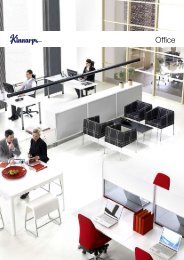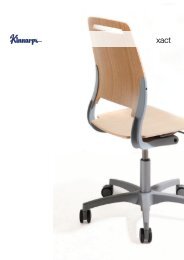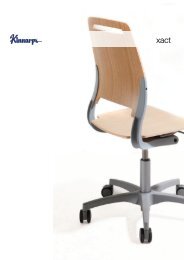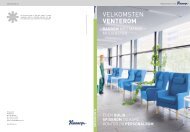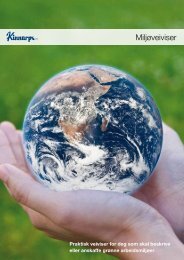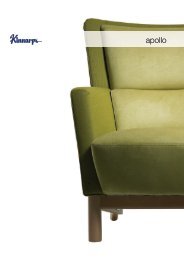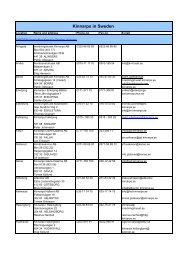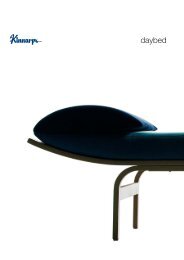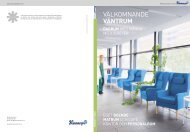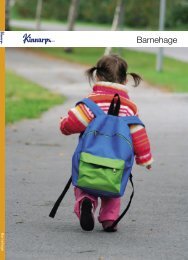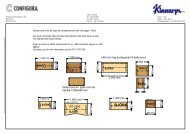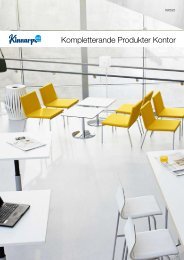Download this issue as pdf - Kinnarps
Download this issue as pdf - Kinnarps
Download this issue as pdf - Kinnarps
You also want an ePaper? Increase the reach of your titles
YUMPU automatically turns print PDFs into web optimized ePapers that Google loves.
<strong>Kinnarps</strong><br />
MAGAZINE NO.7<br />
4xMissions<br />
<strong>Kinnarps</strong>' largest product<br />
launch ever<br />
Cartoon Network<br />
<strong>Kinnarps</strong> furnishes a London studio<br />
under the eaves near Oxford Street<br />
Synnöve Mork<br />
Space-creating textiles with<br />
new advanced techniques<br />
Space Planning<br />
Mobility within and outside<br />
the office calls for meticulous<br />
furnishing solutions
Arbetsstol 9000 design Johan Larsvall Torbjörn Höjer
Contents no. 7<br />
2 Form and function in four new product series<br />
<strong>Kinnarps</strong> presents its largest product launch ever<br />
8 Materia.Klaessons and Skandiform<br />
at the 2007 Stockholm Furniture Fair<br />
10 Textile architecture<br />
Synnöve Mork on new creative fabrics, innovative materials etc<br />
14 Mobile employees and flexible offices<br />
Incre<strong>as</strong>ed mobility both inside and outside the office calls for<br />
meticulous furnishing solutions<br />
18 Mobility is the name of the game<br />
Sitting h<strong>as</strong> become a health problem. So it’s important for<br />
furniture to encourage mobility, insists Peter van Scheijndel,<br />
ergonomist at VHP Ergonomics.<br />
21 Cartoon network<br />
New animated TV series are being produced in a new environment<br />
with furniture from <strong>Kinnarps</strong>, Materia.<br />
24 Announcements<br />
In <strong>this</strong> edition of <strong>Kinnarps</strong> Magazine you can read about our largest<br />
product launch ever. At the Stockholm Furniture Fair in February,<br />
we presented four new product series of chairs, desks, screens<br />
and executive furniture. We also visit Turner House in London where<br />
the TV channel Cartoon Network h<strong>as</strong> furnished its new offices with<br />
some of our latest products.<br />
You can also read about how ever more expensive office rents<br />
have led to an incre<strong>as</strong>ingly efficient use of office space and more<br />
flexible furniture. Higher demands are also being made on the work<br />
environment, not le<strong>as</strong>t in an ergonomic sense, <strong>as</strong> we are becoming<br />
more mobile in our work while at the same time spending more time<br />
seated than ever before. We also meet interior designer Synnöve<br />
Mork who tells us how fabrics can transform and expand spaces.<br />
Space-creating fabrics have a lot to do with advanced techniques<br />
and innovative materials. Happy reading!<br />
Per-Arne Andersson<br />
CEO, <strong>Kinnarps</strong> Marketing & Sales AB
4xMissions<br />
Form and function<br />
in four new product series<br />
The market for office furniture is growing in line with the demand for greater<br />
flexibility, ergonomics and functionality. Trends may come and go, but chairs, desks,<br />
screens and storage solutions remain a constant theme. At the Stockholm Furniture<br />
Fair, the largest in Scandinavia, <strong>Kinnarps</strong> presented its most ambitious product launch<br />
ever, known collectively by the name of 4xMissions.<br />
Most of us work an eight hour day. Many employers<br />
have realised the value of <strong>as</strong>suring the well-being of<br />
their staff and are consequently incre<strong>as</strong>ingly insisting<br />
on better ergonomics <strong>as</strong> well <strong>as</strong> greater flexibility<br />
and functionality in the work environment. During<br />
the l<strong>as</strong>t ten years, the boundary between furniture<br />
designed for offices and for the home environment<br />
h<strong>as</strong> also begun to fade: reception are<strong>as</strong> may remind<br />
us more of a private hall, meeting rooms resemble<br />
living rooms and kitchens are made cosy and<br />
welcoming.<br />
Many interior designers who specialise in work<br />
environments point out that personalised furniture,<br />
often with a ”cosy feel”, h<strong>as</strong> become another way<br />
of defining a company’s identity: by reflecting its<br />
activities and policy, the furniture helps to give it<br />
a strong profile. The 2007 Stockholm Furniture<br />
Fair, the largest and most important in Scandinavia,<br />
showed a clear trend among office furniture<br />
suppliers: a range of solutions for attenuating sound<br />
and permitting a degree of seclusion. They show a<br />
concern for the people who have to work in today’s<br />
KINNARPS MAGAZINE 2007 3
Deciso desk, Deciso storage unit, 9000 office chair, 9000[cv] visitor’s chair<br />
“It w<strong>as</strong> important for us to discreetly put across our view<br />
of good design – of which the form is an integral part.”<br />
Monroe<br />
offices with their hard floors, extreme ceiling<br />
heights, large window are<strong>as</strong>, open-plan offices and<br />
often a complete lack of textiles. In cooperation<br />
with Christian Halleröd, <strong>Kinnarps</strong> h<strong>as</strong> produced<br />
the Rezon system, one of the market’s most flexible<br />
screen solutions: an interior and system screen that<br />
truly embodies the word flexibility. Exchangeable<br />
modules – rather like building blocks – in various<br />
materials and colours inspire the user to build,<br />
change and rearrange his furniture according to his<br />
preferences, t<strong>as</strong>tes and needs.<br />
The Rezon screen solution w<strong>as</strong> part of <strong>Kinnarps</strong><br />
extensive display at Stockholm’s Furniture Fair.<br />
Under the collective name of 4xMissions, the<br />
company presented Rezon <strong>as</strong> well <strong>as</strong> several<br />
completely new product series; the 9000 series of<br />
office and visitors’ chairs, the Series[f] desks and the<br />
Deciso series of executive and conference furniture.<br />
4<br />
KINNARPS MAGAZINE 2007
4xMissions<br />
9000 office chair, 9000[cv] visitor’s chair, Series[f] desk, Series[XD] storage unit<br />
“The launch saw its premiere in Stockholm and will<br />
reach the rest of the world during the year”, states<br />
Per-Arne Andersson, CEO of <strong>Kinnarps</strong> Marketing<br />
& Sales AB. “This is our largest product launch<br />
ever, and we have developed and refined our range<br />
of integrated solutions for offices, schools and the<br />
care sector”, he added.<br />
Why now and why with these products? “Well,<br />
we wanted to review these four large sectors<br />
in particular and discussed the desired results,<br />
which took between one and four years to<br />
produce concurrently”. How did you work out<br />
what should be done? “Thanks to an extensive<br />
network of contacts with users and distributors, we<br />
obtained a solid input of viewpoints that became<br />
the b<strong>as</strong>is for developing these four product series.<br />
It w<strong>as</strong> important for us to discreetly put across<br />
our view of good design – of which the form<br />
is an integral part. Cost-effectiveness, technical<br />
innovations, functionality, ergonomics, user-<br />
Rezon screen system<br />
KINNARPS MAGAZINE 2007 5
friendliness, flexibility, minimized use of resources<br />
and environmental thinking are other components<br />
of the concept that are very important for us. So<br />
we always work in an integral way.”<br />
The other three series may be described in<br />
various ways: the Series[f] desks by Danish designer<br />
Anders Nørgaard can be summed up <strong>as</strong> lightweight<br />
strength. The highlight of the 9000 series of chairs,<br />
designed by Johan Larsvall and Torbjörn Höjer,<br />
is the t<strong>as</strong>k chair of the same name. The results of<br />
customer surveys have led to an e<strong>as</strong>y-to-use guide<br />
in 14 languages (see www.kinnarpscomfortcontrol.<br />
com) so that everyone can e<strong>as</strong>ily understand how<br />
simple it is to ensure optimal seating – or, <strong>as</strong><br />
<strong>Kinnarps</strong> points out, different ways of adjusting the<br />
seating, because it is ergonomically important to<br />
vary one’s posture during the working day. It w<strong>as</strong><br />
therefore also vital to make the control panel and<br />
its regulation visible to the user.<br />
Deciso is a series of executive furniture<br />
comprising desks and storage units for offices and<br />
conference rooms with clean simple lines: the<br />
designers at Britain’s Wills Watson+Associates call<br />
it a kind of soft minimalism that continues the<br />
Scandinavian tradition. Great care h<strong>as</strong> been taken<br />
to <strong>as</strong>sure perfect function and finish. In addition,<br />
the display and storage cabinets are provided with<br />
neat reverse panels to incre<strong>as</strong>e their furnishing<br />
flexibility.<br />
“Our ambition with the new series is naturally<br />
to satisfy the ever higher demands made in terms<br />
of ergonomics, functionality and flexibility. We also<br />
think that these innovations set a new standard in<br />
their respective product cl<strong>as</strong>ses. The design and<br />
application options of the screen system, the userfriendly<br />
comfort of the t<strong>as</strong>k chair, the lightweight<br />
top of the desk series and the strong personality of<br />
the executive furniture.<br />
It will be really exciting to see the results when our<br />
products reach the market,” concludes Per-Arne.<br />
susanne helgeson<br />
6<br />
KINNARPS MAGAZINE 2007
Premiere showing of the new products in Sweden, Finland and France<br />
The guests arrived at the <strong>Kinnarps</strong><br />
Interiors exhibition in central Stockholm<br />
the day before the Stockholm Furniture<br />
Fair opened its doors<br />
<strong>Kinnarps</strong> Finland products were shown<br />
to 400 guests in the Old Student House<br />
in Helsinki<br />
The products were shown to a large<br />
number of guests in <strong>Kinnarps</strong> France’s<br />
exhibition in Orgeval<br />
KINNARPS MAGAZINE 2007 7
Stockholm Furniture Fair 2007<br />
Mooses, Klaessons<br />
Praline Noir, Materia<br />
Playfulness meets tradition<br />
“Materia’s designs are rather playful and<br />
experimental while Klaessons h<strong>as</strong> a more traditional<br />
and m<strong>as</strong>culine image”, observes Fredrik Ehrnström,<br />
Head of Sales and Marketing at Materia.Klaessons<br />
AB. When you work with two very diverse brands<br />
within the same company you have to distinguish<br />
them carefully. It’s important that both design<br />
and marketing clearly bring out their respective<br />
identities. Fredrik Ehrnström expands om his<br />
theme:<br />
“We like to say that Klaessons stands for European<br />
elegance with its more established models and<br />
well-known designers. In contr<strong>as</strong>t, Materia strives<br />
to be experimental and engages young and exciting<br />
designers to realize new ide<strong>as</strong>. For instance, we’ve<br />
now developed a real eye-catcher, an “identitycreating”<br />
type of seating known <strong>as</strong> Praline Noir.<br />
L<strong>as</strong>t year we launched Märta Friman’s table Ava <strong>as</strong><br />
well <strong>as</strong> Front’s w<strong>as</strong>te paper b<strong>as</strong>ket Bin that swells <strong>as</strong><br />
it fills up.<br />
“Praline Noir is a cross between a sofa and<br />
a bench, an upholstered piece of furniture for<br />
unconventional seating – exclusive and unique.<br />
The buttons are the fine point of detail: no Praline<br />
is exactly identical to any other. But Materia also<br />
does a lot with more discretion and in pure style,<br />
for instance its accessories such <strong>as</strong> hat-racks, coathooks<br />
and umbrella stands.”<br />
The Klaessons label stands for a more coherent<br />
line than Materia’s. The focus is on furniture for<br />
meeting rooms and conference facilities. Among<br />
<strong>this</strong> year’s innovations are variants of the Mayflower<br />
series – a bar stool and a bench – designed by Lars<br />
Pettersson and Thom<strong>as</strong> Bernstrand. As well <strong>as</strong> the<br />
Mooses chair created by veterans Simo Heikkilä<br />
and Yrjö Wiherheimo.<br />
“They made use of moulded felt, which is<br />
extremely hardwearing. I have a lot of faith in<br />
Mooses. It h<strong>as</strong> an international touch and is made<br />
of quite unique materials.”<br />
lotta jonson<br />
Facts about Materia.Klaessons AB<br />
Materia.Klaessons develops<br />
superbly designed furniture<br />
and fittings for creative meeting<br />
places in offices and public<br />
environments<br />
A member of the <strong>Kinnarps</strong><br />
group since 2004<br />
www.materia.se<br />
www.klaessons.com<br />
8<br />
KINNARPS MAGAZINE 2007
Stockholm Furniture Fair 2007<br />
Woodstock, Skandiform<br />
Long-term design at Skandiform<br />
“A long-term view and a clear focus are key <strong>as</strong>pects<br />
of our innovations program”, says Magnus Gårdhed,<br />
CEO of Skandiform AB. “That means long-term<br />
thinking at several levels; we like to stick with the<br />
designers with whom we work well together. And<br />
some of the furniture h<strong>as</strong> been part of our range<br />
for almost fifty years.”<br />
Skandiform h<strong>as</strong> two business sectors: Contract<br />
and Care.<br />
Some ten innovations within each of them<br />
were presented at the Stockholm Furniture Fair in<br />
February.<br />
“We adopt quite a different approach for each<br />
sector. Care offers furniture addressed to healthcare<br />
users, quite simply for all types of care. It satisfies<br />
the special demands made on seating heights<br />
and general comfort. Function h<strong>as</strong> to determine<br />
design. Within our Care program, we have recently<br />
launched Woodstock, a new comprehensive series<br />
consisting of various types of chairs, armchairs,<br />
sof<strong>as</strong>, tables and storage units. By contr<strong>as</strong>t, the<br />
design factor plays a bigger role in our Contract<br />
range, which comprises interior furniture for<br />
offices and public spaces.<br />
“The concept of modular furniture fits well into<br />
our production process”, thinks Magnus Gårdhed.<br />
“We like our customers to give us their preferences<br />
<strong>as</strong> far <strong>as</strong> possible, so that we can select various items<br />
and put them together entirely according to their<br />
wishes. So everyone gets his own unique suite of<br />
furniture.”<br />
This high flexibility is particularly characteristic<br />
of Playtime, an innovation within the Contract<br />
program. Jon<strong>as</strong> Lindvall, who regularly designs for<br />
Skandiform, h<strong>as</strong> played with both dimensions and<br />
colour schemes in a range of variants.<br />
“The second new sofa within the Contract range,<br />
known <strong>as</strong> the Concorde and designed by Matti<strong>as</strong><br />
Ljunggren, is perhaps a bit more conventional”, says<br />
Magnus Gårdhed. “But it’s an on-going challenge<br />
to find distinctive designs for various t<strong>as</strong>tes.”<br />
lotta jonson<br />
Facts about Skandiform AB<br />
Skandiform stands for design,<br />
function and quality.<br />
It develops and supplies<br />
furniture for offices and<br />
public spaces.<br />
A member of the <strong>Kinnarps</strong><br />
group since 2004.<br />
www.skandiform.com<br />
KINNARPS MAGAZINE 2007 9
Synnöve Mork<br />
Fabric room divider<br />
Richly patterned origami<br />
Textile architecture<br />
Synnöve’s mission =<br />
“Oh no – not another roll of curtain material,”<br />
I thought to myself.<br />
Synnöve Mork, textile and internal designer, talks<br />
about Soft Walls, the exhibition that created quite<br />
a stir at the Stockholm Furniture Fair a couple of<br />
years ago. An installation that managed to convey<br />
the feeling of textiles <strong>as</strong> architecture. Draped<br />
felt lamell<strong>as</strong>, l<strong>as</strong>er-cut polyester webs, fluffy or<br />
perforated fabrics formed the “building material”<br />
and created a feeling of space. Patterns, cushions<br />
and curtain material, that’s what we often think<br />
of when we hear the word textiles. But Synnöve<br />
and her fellow exhibitors, a group of her students<br />
from the Art Academy’s textiles course, presented a<br />
different vision. Sensual and poetic, but at the same<br />
time combining spatial and functional <strong>as</strong>pects.<br />
Soft Walls scored a hit. Visitors, not le<strong>as</strong>t architects,<br />
flocked to the graphically stunning installations<br />
arrayed completely in black, white and grey. Even<br />
buyers queued up. Although the exhibition w<strong>as</strong> not<br />
at all meant to be a sales event, commercial interest<br />
w<strong>as</strong> equally strong.<br />
“Many of the ide<strong>as</strong> in the exhibition are now in<br />
production,” she says. “Although it’s not something<br />
we had thought about.”<br />
That w<strong>as</strong> spring 2005. She’s now contemplating<br />
how to take the concept further. The next time<br />
the idea is to juxtapose textiles and light even<br />
more distinctly. Soft Walls already highlighted the<br />
role of textiles <strong>as</strong> an excellent means of screening<br />
off, filtering and distributing the light in various<br />
ways. Now, the light sources should, <strong>as</strong> it were, be<br />
10<br />
KINNARPS MAGAZINE 2007
Synnöve Mork<br />
Clippings, pieces of fabric and invented symbols form part of Synnöve Mork’s office<br />
woven into the fabrics themselves. To make them<br />
light up and live. Light designer Gunnar Bjurs and<br />
Synnöve Mork had worked together before and<br />
became creative sparring partners and experts in<br />
<strong>this</strong> technique.<br />
Space-creating textiles have a lot to do with new<br />
advanced techniques. Such <strong>as</strong> innovative materials<br />
developed by science, often with application<br />
are<strong>as</strong> far beyond the normal domains of interior<br />
design. L<strong>as</strong>er-cut polyester webs, fibre optics, highperformance<br />
composites, carbon-fibres and prepeg<br />
tape, the kind of materials and techniques normally<br />
found in aircraft and advanced sports goods, for<br />
example, also promote spatial creativity at home,<br />
in workplaces and public spaces. With distinctive<br />
results that create a greater impact than traditional<br />
textiles.<br />
“There’s so much going on in the field of material<br />
research”, she says. “But it’s rare to see innovations<br />
transformed into concrete spatial dimensions.”<br />
However, <strong>this</strong> development h<strong>as</strong> already been<br />
under way for several years on the international<br />
scene. Around the turn of the millennium, newly<br />
created textile wall elements began to make their<br />
appearance, such <strong>as</strong> Teppo Asikainen’s billowing wall<br />
panel in felt, Soundwave, and later the Bouroullec<br />
brothers’ much praised ”fabric tile” North Tile.<br />
And way back in the 1980s experimental architects<br />
like Shigeru Ban from Japan presented structures<br />
such <strong>as</strong> the famous Curtain Wall House and Naked<br />
House: the walls of the first were simply made of<br />
lofty white draperies from ceiling to floor, and<br />
those of the second from corrugated fibre-gl<strong>as</strong>s<br />
reinforced pl<strong>as</strong>tic.<br />
But the concept of textile spaces had not yet<br />
found its way into homes and office environments.<br />
Synnöve Mork also thought that the new textile<br />
wall elements were often overtly m<strong>as</strong>culine. B<strong>as</strong>ed<br />
on mathematics, system and repetition, a rational<br />
way of seeing that she would really have liked<br />
to complement with a poetic dimension – but<br />
without giving them the triteness of mere decor.<br />
“I’m really p<strong>as</strong>sionately keen to create spaces<br />
with textiles, I’ve been doing it for <strong>as</strong> long <strong>as</strong> I can<br />
remember,” she says.<br />
Things got off to a good start when she began<br />
lecturing in textiles at the Art Academy in the<br />
1990s. Early on she gave her students architecturally<br />
angled <strong>as</strong>signments involving elements such <strong>as</strong> light<br />
and shadow. Architects were invited in, <strong>as</strong> were<br />
experts in Venetian blinds and textile fant<strong>as</strong>ists such<br />
<strong>as</strong> Margot Barolo. From the small to the large – she<br />
even sent her students out to the residential are<strong>as</strong><br />
around Stockholm, some of which were still only<br />
building sites. She hoped that <strong>this</strong> would open their<br />
eyes to phenomena such <strong>as</strong> inward and outward<br />
views, how light and sound spread, how they are<br />
experienced.<br />
“I love patterns,” she says. “But not the idea that<br />
textiles should only be concerned with patterns.”<br />
The time <strong>as</strong> a teacher w<strong>as</strong> really great, she feels.<br />
A useful learning experience. It also forced her to<br />
develop the language of textiles and form, not le<strong>as</strong>t<br />
to clarify her own position. This w<strong>as</strong> crucial for<br />
the students, <strong>as</strong> she discovered. In 1980 she left the<br />
Art Academy’s textile course and claims that at that<br />
time she hardly said a word. Now she had to be<br />
both clear and open, something that she would like<br />
12<br />
KINNARPS MAGAZINE 2007
Synnöve Mork<br />
“Space-creating textiles have a lot to do with new advanced techniques.<br />
Such <strong>as</strong> innovative materials developed by science, often with application<br />
are<strong>as</strong> far beyond the normal domains of interior design.”<br />
to see more of in the everyday talk about design.<br />
There’s just too much ”Oh, how lovely”, ”Oh, how<br />
exquisite”, she feels. And not enough well thought<br />
out and constructive dialogue.<br />
But <strong>as</strong> enriching <strong>as</strong> it w<strong>as</strong> to be a teacher, it w<strong>as</strong><br />
equally marvellous to return to her own creative<br />
work. She continues to maintain contact with<br />
many of her former students. Several of them have<br />
become her close friends. Some of them were<br />
involved in Soft Walls. And some of them, like Anna<br />
Danielsson, now with Marimekko, have become<br />
extremely successful.<br />
“It’s exciting to see a star being born”, says<br />
Synnöve. “In Anna’s c<strong>as</strong>e it w<strong>as</strong> immediately<br />
apparent what a distinctive c<strong>as</strong>t of mind she<br />
possessed.”<br />
To stage-set and display textiles and other<br />
designs h<strong>as</strong> become Synnöve Mork’s medium,<br />
more in fact than ”normal” textile creation. But<br />
“soft walls” can be built out of many materials,<br />
not just fabrics. Flowers are the latest element of<br />
her repertoire, <strong>this</strong> time together with landscape<br />
architect Ulf Nordfjell, known for his work with<br />
many major garden projects. L<strong>as</strong>t Christm<strong>as</strong>, they<br />
created an installation together in Gothenburg in<br />
the legendary greenhouse of the city’s Gardening<br />
Association. Two globe-shaped rooms of plants<br />
were placed opposite each other. One circus-like,<br />
chaotic with draperies made of flowers in amazing<br />
colours, the other with only white and pale flowers,<br />
frostily austere and wintry.<br />
”Really way out,” she says. ”But fant<strong>as</strong>tic. Spaces<br />
can be created in the most unexpected ways.”<br />
ingrid sommar<br />
Soft Walls exhibition at the Stockholm Furniture Fair<br />
Photo Per Ranung<br />
KINNARPS MAGAZINE 2007 13
Space Planning<br />
Swiftly rising office rents have encouraged<br />
ever more efficient use of office space.<br />
This, together with incre<strong>as</strong>ing mobility<br />
both within and outside the office, calls<br />
for meticulous interior-design solutions<br />
and even more flexible furniture.<br />
Mobile employees and<br />
flexible offices<br />
The cost of office space h<strong>as</strong> incre<strong>as</strong>ed so much that<br />
more and more companies feel forced to downsize<br />
their offices – a trend that started in the USA and is<br />
now spreading to the major cities of the world.<br />
A few years ago, a normal workplace in an office<br />
took up about 10 square metres. Today <strong>this</strong> space h<strong>as</strong><br />
been halved. This trend seems to have gone further<br />
in the UK than among its European neighbours.<br />
“We have large open-plan offices where the<br />
space that each workplace may take up is shrinking<br />
all the time. We are now down to a minimum of<br />
four square meters for each workplace, including<br />
circulation space and storage”, says Alexander<br />
Gifford, Head of Design at <strong>Kinnarps</strong> in the UK.<br />
That – namely four square meters per workplace<br />
– is where the trend h<strong>as</strong> stopped for the time being.<br />
It would hardly be fe<strong>as</strong>ible to make it less. But<br />
offices will nevertheless shrink further <strong>as</strong> employees<br />
become incre<strong>as</strong>ingly mobile and workplaces are<br />
<strong>as</strong>signed less and less to individuals. Quite simply,<br />
not everyone will need their own desk in future.<br />
14<br />
KINNARPS MAGAZINE 2007
The trend towards an ever more compact office<br />
environment h<strong>as</strong> had many knock-on effects. One<br />
of the most obvious is that desks are shrinking in<br />
size. Space-guzzling corner desks are disappearing<br />
and are being replaced by rectangular desks with<br />
much smaller work are<strong>as</strong>. They vary from 120cm to<br />
180 cm long and 80 or at most 90 cm deep. Mobile<br />
meeting tables are used to give extra space where<br />
needed, giving a more flexible layout<br />
Smaller desks would have been a problem if<br />
computers had not shrunk <strong>as</strong> well. Today’s flat<br />
monitors and laptops take up much less space than<br />
the old bulky CRTs.<br />
The more efficient use of space means that people<br />
are working closer to each other. This in turn h<strong>as</strong> a<br />
number of consequences for interior designers.<br />
Sound muffling by screens and fabrics is<br />
becoming incre<strong>as</strong>ingly important <strong>as</strong> a means of<br />
reducing disturbances at work, so that screens <strong>as</strong><br />
well <strong>as</strong> cabinet backs are now being developed<br />
with new sound-absorbent materials. Another<br />
challenge is the sunlight coming through the large<br />
gl<strong>as</strong>s are<strong>as</strong> of new offices: the furniture h<strong>as</strong> to be<br />
arranged to prevent the light falling directly onto<br />
the monitors.<br />
The new technology is accompanied by cables.<br />
Keeping them tidy is another problem that h<strong>as</strong><br />
to be solved. The efficient running of cables is a<br />
particular must in open-plan offices. We have<br />
always had cables – even with the introduction of<br />
new technology and wireless working there is still<br />
a need for numerous chargers and transformers for<br />
computers and their peripherals.<br />
On the whole, smaller are<strong>as</strong> mean more layout<br />
effort: where through-routes should run in order<br />
not to disturb anyone, where people with various<br />
functions should have workplaces in an open-plan<br />
office, where quiet rooms are to be located etc.<br />
“The real challenge is to turn a smaller space<br />
to your advantage. A more compact office can<br />
help people communicate better”, says Alexander<br />
Gifford.<br />
KINNARPS MAGAZINE 2007 15
Space Planning<br />
Project: London Borough of Ealing, UK<br />
“Finding the balance between less space<br />
and function is the real challenge”<br />
Alexander Gifford, Head of Design,<br />
<strong>Kinnarps</strong> UK<br />
Katerina Norman, interior designer,<br />
<strong>Kinnarps</strong> Interior Stockholm<br />
Philippe Arin, Head of Design,<br />
<strong>Kinnarps</strong> France<br />
Shared spaces are becoming very much more<br />
important and take up an ever larger part of the<br />
entire office. Small quiet telephone rooms, coffee<br />
rooms, meeting rooms, are<strong>as</strong> for printers and other<br />
office machines must be given incre<strong>as</strong>ingly strategic<br />
locations.<br />
“When we move away from personal workplaces<br />
with large desks, we have to make an effort to<br />
make the rest of the environment all the more<br />
ple<strong>as</strong>ant. Are<strong>as</strong> for breaks and meetings must be<br />
places where people want to be and are inspired to<br />
communicate”, observes Alexander Gifford.<br />
For users of the new office environments, all <strong>this</strong><br />
h<strong>as</strong> meant something of a revolution.<br />
Shrinking workplaces obviously reduce space<br />
for the private sphere in the office. Personal<br />
objects such <strong>as</strong> potted plants and family photos are<br />
banished. This is something that Katarina Norman<br />
at <strong>Kinnarps</strong> Interior in Stockholm h<strong>as</strong> had to<br />
contend with.<br />
“It’s often hard to get the employees on our side<br />
when moving to an open-plan office. Most of them<br />
don’t want to change anything. So we go much<br />
deeper to user level at the planning stage”, says<br />
Katarina Norman.<br />
16<br />
KINNARPS MAGAZINE 2007
Loss of one’s private office space h<strong>as</strong> clearly not<br />
come quite <strong>as</strong> far in Scandinavia <strong>as</strong> in London and<br />
Paris.<br />
Working life centres incre<strong>as</strong>ingly around<br />
communications. Employees move more and more<br />
within the office. From focused computer work<br />
at small workplaces to breaks with a newspaper<br />
on a sofa, a cup of coffee and a bit of a chat in<br />
the café, customer meetings in the meeting room<br />
or a confidential call in one of the many small<br />
phone rooms. All of them made possible by the<br />
development of laptops, cordless phones and f<strong>as</strong>t<br />
wireless network connections.<br />
Incre<strong>as</strong>ed mobility takes place not only within<br />
the office but also outside it. The trend is clear, and<br />
employees will find themselves incre<strong>as</strong>ingly out<br />
of the office in future, believe <strong>Kinnarps</strong> designers.<br />
We are seeing more and more mobile employees,<br />
known <strong>as</strong> office nomads.<br />
“Nomads who spend 80 percent or more of their<br />
working time away from the office do not need a<br />
fixed workplace”, observes Philippe Arin, Head of<br />
Design at <strong>Kinnarps</strong> in France.<br />
“If a customer h<strong>as</strong> 100 employees, possibly no<br />
more than 60 of them will be at the office at any<br />
one time. The others are mobile. They are out<br />
selling. Or working on their laptops at home or<br />
at some Starbucks in town. So that customer does<br />
not need 100 workplaces”, points out Alexander<br />
Gifford.<br />
Mobile employees come to work for a meeting<br />
with their superiors and connect their laptops at a<br />
free area shortly before or after the meeting before<br />
returning home to work on their computers in a<br />
more focused way.<br />
Incre<strong>as</strong>ingly flexible employees set up new<br />
projects, continuously form new teams that quickly<br />
arrange themselves around a suitable combination<br />
of desks in a corner.<br />
Mobile, flexible employees – that is the future.<br />
The same applies to mobile, flexible office<br />
environments.<br />
ann-marie Åsheden<br />
KINNARPS MAGAZINE 2007 17
The importance of mobility<br />
The human body is far from happy to sit still all the time! It is designed for movement<br />
and soon begins to make <strong>this</strong> quite clear. It protests with stiff joints, pain in the back,<br />
shoulders and hips. And yet we are forced to sit in front of computers and control<br />
panels since our jobs have become automated. But we also sit more at home too: we<br />
do our shopping via the Internet and communicate by e-mail – we don’t even have<br />
to go <strong>as</strong> far <strong>as</strong> the nearest letterbox. Of course, a visit to the gym or a training session<br />
goes a long way to compensate for a sedentary lifestyle, but do we have enough time<br />
– and energy – for them?<br />
18<br />
KINNARPS MAGAZINE 2007
The importance of mobility<br />
When the ergonomists (Greek. ergon = work and<br />
nomia = knowledge) first turned their attention<br />
to the production sector some fifty years ago,<br />
their interest focused on tools and monotonous<br />
movements in heavy work processes. In offices,<br />
they initially looked at seating curves, the tilt of<br />
backrests, elbow and neck angles etc.<br />
Only in the 1990s with the advent of computers in<br />
every workplace did office employees become an<br />
interesting object of study. And now, fifteen years<br />
later, the key <strong>issue</strong> is mobility. At any rate that’s<br />
what Peter van Scheijndel thinks:<br />
“More and more people work in offices, but<br />
more office work is also done at home. People<br />
are becoming less and less mobile. The sedentary<br />
lifestyle h<strong>as</strong> become a real health problem. So it’s<br />
important for furniture to encourage mobility.<br />
Peter van Scheijndel is an ergonomist and partowner<br />
of VHP Ergonomics, a Dutch company<br />
with about 25 employees that advice, design<br />
and conducts ergonomic research. He notes that<br />
Scandinavia is, together with the Netherlands,<br />
at the forefront of developing office furniture of<br />
ergonomic design.<br />
It’s a major challenge to satisfy all categories<br />
of people with one and the same chair. But<br />
considerable success h<strong>as</strong> already been achieved in<br />
doing <strong>this</strong>. Office chairs are becoming more and<br />
more adjustable. But Van Scheijndel feels that there’s<br />
a major problem. The refinements are not used: 80<br />
percent of users ignore – or fail to understand – the<br />
full potential of a chair.<br />
“If office staff were to use furniture more<br />
effectively, there would be fewer occupational<br />
injuries and a better work environment, fewer days<br />
off sick and greater profitability for the companies<br />
<strong>as</strong> a result.<br />
Today, we often hear people discussing the<br />
respective virtues of the FreeFloat and Synchron<br />
settings in office chairs. In brief: in the synchron<br />
position, the backrest and seat follow each other<br />
automatically. The angle between them follows<br />
your movements and changes freely and flexibly<br />
when you lean back in your chair, for example.<br />
This means that your hip joint h<strong>as</strong> to move, which<br />
is good from a health perspective. It would be even<br />
better if the seat could also have some scope for<br />
swaying freely. It can do <strong>this</strong> in the FreeFloat setting.<br />
KINNARPS MAGAZINE 2007 19
The importance of mobility<br />
Peter van Scheijndel, VHP Ergonomics<br />
“More and more people work in offices, but more office work is also done at home.<br />
People are becoming less and less mobile. The sedentary lifestyle h<strong>as</strong> become a real<br />
health problem. So it’s important for furniture to encourage mobility.<br />
Your hips, thighs and back then move around even<br />
more in the chair. Some people think <strong>this</strong> feels a bit<br />
wobbly, and most need a while to get used to it.”<br />
What does Peter van Scheijndel think of the new<br />
<strong>Kinnarps</strong> 9000 series?<br />
“The armrest h<strong>as</strong> been improved. And all the<br />
adjustment controls are clearly visible. That’s<br />
important. The adjustment options are used less<br />
if they cannot be seen. The core question from<br />
an ergonomic viewpoint is to induce the user to<br />
adjust his chair.”<br />
Desks of adjustable height have so far been more<br />
usual in Scandinavia than in other parts of Europe.<br />
What does the ergonomist from The Hague think<br />
of them?<br />
“We must try to combat sedentary behaviour.<br />
People who alternately stand and sit during their<br />
work move around at le<strong>as</strong>t a little during the day.<br />
Ergonomic studies show that people continuously<br />
try to change their position when sitting. A heightadjustable<br />
desk can give scope to <strong>this</strong> obvious need<br />
to move around.”<br />
In other words, mobility is indeed of the<br />
essence.<br />
Finally, Peter van Scheijndel points out that<br />
ergonomics applied to office furniture is not<br />
merely a matter of comfort but should cover the<br />
total life cycle. Instead of merely focusing on the<br />
end-user’s ergonomics, one should also think about<br />
how the furniture affects those who manufacture<br />
and <strong>as</strong>semble it. As well <strong>as</strong> the cleaners and those<br />
who transport it to the office.<br />
“<strong>Kinnarps</strong> new desks are reputed to weigh a<br />
third of their predecessors. That’s just fant<strong>as</strong>tic.<br />
These days it’s quite common to move office at<br />
le<strong>as</strong>t every other year, so weight matters a lot. Not<br />
le<strong>as</strong>t in purely ergonomic terms.”<br />
lotta jonson<br />
Office chair 9000<br />
20<br />
KINNARPS MAGAZINE 2007
Cartoon Network<br />
The words “Turner House” stand above the<br />
entrance to the six-storey building on Great<br />
Marlborough Street diagonally opposite<br />
Liberty’s cl<strong>as</strong>sical store and at its rear<br />
directly adjoining the London Palladium,<br />
the capital’s premier venue for musicals.<br />
It is the main European office of Atlantab<strong>as</strong>ed<br />
TV giant Turner Broadc<strong>as</strong>ting System<br />
Europe Limited, whose portfolio includes<br />
a number of well-known channels such<br />
<strong>as</strong> CNN, Cartoon Network and Turner<br />
Cl<strong>as</strong>sic Movies (TCM).<br />
Media-customized<br />
furniture at Cartoon<br />
© Turner House<br />
The lobby leaves a visitor in no doubt <strong>as</strong> to<br />
the world he h<strong>as</strong> just entered. The architects from<br />
leading practice Reid Architecture have designed<br />
a reception environment that takes him straight<br />
into TV land. Programs from the various Turner<br />
channels are shown on small TV screens placed in<br />
niches in the mellow-yellow walls.<br />
Turner’s European subsidiary h<strong>as</strong> had a business<br />
relationship with <strong>Kinnarps</strong> that h<strong>as</strong> l<strong>as</strong>ted for almost<br />
two decades, most visibly during the period 1996-<br />
2006, when all the functional <strong>Kinnarps</strong> furniture<br />
of the CNN editorial office could be seen on the<br />
screen around the clock.<br />
“We needed furniture to satisfy diverse<br />
t<strong>as</strong>tes. Where<strong>as</strong> the ambience at CNN is more<br />
conservative, the young team running Cartoon<br />
prefer furniture with a modern and up-to-date<br />
feel.” says Russell Parry, Vice President of Facilities<br />
in Europe for Turner Broadc<strong>as</strong>ting System Europe<br />
Limited.<br />
Cartoon Network, CN, h<strong>as</strong> a distinguished<br />
history going back to the legendary Hanna-Barbera<br />
productions: William Hanna and Joseph Barbera<br />
were behind super cl<strong>as</strong>sics such <strong>as</strong> The Flintstones<br />
and Scooby-Doo. But the Cartoon Network<br />
started by Turner in 1993 is now also focusing on<br />
creating new major series such <strong>as</strong> Ben 10, Foster’s<br />
Home for Imaginary Friends and Skatoony.<br />
And the recently furbished Development Studio<br />
under the eaves close to Oxford Street w<strong>as</strong> built<br />
KINNARPS MAGAZINE 2007 21
“The office furniture in <strong>this</strong> company must live up to high standards.<br />
And it’s also vital for us that everything we buy in is flexible so that it<br />
can be e<strong>as</strong>ily moved to other units within the company”.<br />
specifically for a new team to create animated TV<br />
for a contemporary audience.<br />
Now more than 20 people work here, a mere<br />
stone’s throw from Turner House. The team w<strong>as</strong><br />
<strong>as</strong>signed a challenging t<strong>as</strong>k: to spearhead the<br />
creation of new animated TV series with a strong<br />
“European” feel.<br />
“The office furniture in <strong>this</strong> company must live<br />
up to high standards”, says Parry. “And it’s also vital<br />
for us that everything we buy in is flexible so that<br />
it can be e<strong>as</strong>ily moved to other units within the<br />
company”.<br />
22<br />
KINNARPS MAGAZINE 2007
Cartoon Network<br />
Among the furniture finally selected for the<br />
Development Studio w<strong>as</strong> the recently launched<br />
9000 series t<strong>as</strong>k chair, <strong>as</strong> well <strong>as</strong> the new Series[f]<br />
desking system, ergonomically designed and with<br />
an extremely lightweight but strong top that w<strong>as</strong><br />
a perfect answer to the needs of both partners.<br />
In addition there are some rather more unusual<br />
elements, like the Plint bar stool designed by Sandin<br />
& Bülow for Materia, <strong>as</strong> well <strong>as</strong> their Centrum<br />
Grande swivel chairs all in an elegant snowy white.<br />
Materia are a fairly recent addition to the <strong>Kinnarps</strong><br />
group – along with Klaessons and Skandiform -<br />
adding a range of design-led products.<br />
“Our complementary brands add a further<br />
dimension to the <strong>Kinnarps</strong> range and make our<br />
total offering even more complete and interesting”,<br />
says Marc Bird, Head of Marketing at <strong>Kinnarps</strong><br />
UK. “Typically, our customers used to buy the<br />
majority of their office furniture from us but<br />
sometimes supplement with a few chosen pieces<br />
from other suppliers. But now, <strong>as</strong> in the c<strong>as</strong>e of<br />
Cartoon Network, they have such a wide choice<br />
of <strong>Kinnarps</strong> furniture they are able to vary their<br />
chosen image, including the signature pieces, all<br />
from one supplier.”<br />
Marc Bird, who h<strong>as</strong> been with <strong>Kinnarps</strong> for<br />
almost 20 years and h<strong>as</strong> a strong sense for Swedish<br />
furniture culture, thinks English people generally<br />
have a strongly positive attitude to everything<br />
Scandinavian. That’s obviously the c<strong>as</strong>e within<br />
the sector of furniture and design. Apart from<br />
that, Sweden’s image in particular is enhanced<br />
by a number of well-known brands with an<br />
international appeal that most British people know<br />
and like, from Volvo and Ericsson to H&M, Abba<br />
and SAS.<br />
ingrid sommar<br />
© Turner House<br />
KINNARPS MAGAZINE 2007 23
Announcements no7<br />
Heavyweight<br />
Phaidon Design Cl<strong>as</strong>sics are among the most<br />
heavyweight works in the world of design books, both<br />
figuratively and literally. A richly illustrated odyssey,<br />
weighing 8.5 kilos, of 999 industrially manufactured<br />
objects “of aesthetic value and timeless quality, genuine<br />
significance, innovative in the use of new materials and<br />
technologies, perfect in their design”. The three bright<br />
yellow volumes are supplied in a durable carrying c<strong>as</strong>e<br />
so they can be taken along with you on holiday so that<br />
you can extend your knowledge and at times smile with<br />
recognition. For Phaidon Design Cl<strong>as</strong>sics is certainly a<br />
piece of design history in which products from various<br />
ages rub shoulders with less well-known but equally<br />
interesting objects that tell us a lot about the prevailing<br />
zeitgeist. And the industry’s praise came thick and f<strong>as</strong>t<br />
after its publication. Swiss architect Peter Zumthor said<br />
“a usable book about design at l<strong>as</strong>t”, British designer<br />
Terence Conran called it “a two-dimensional design<br />
museum” and his fellow countryman, architect John<br />
Pawson: “A special joy for a man like me who hates<br />
objects but loves design”.<br />
Unbearable tension<br />
Stockholm’s public library, designed by Swedish architect Gunnar Asplund and built in 1928, is one of the world’s<br />
best-known buildings in architectural circles. It is now being extended and modernised, and the competition for <strong>this</strong><br />
prestigious job is one of the most exciting and fiercely contested among <strong>this</strong> group. Six contributions have been<br />
short-listed from about 1,100 proposals sent in from 120 countries and a wider selection is on tour for public viewing<br />
before the final winner is nominated. It will also be shown at the House of Culture (Kulturhuset), the Museum of<br />
Architecture and the Municipal Museum in Stockholm. The six finalists will receive SEK 300,000 in order to develop<br />
their proposals further for resubmission to the jury whose decision will be announced in November.<br />
Two of the six semi-finalists are The Book Hill, that proposes a light and open-roof landscape linking the hill above<br />
the library with the street below it, and Poet’s Corner, whose soft wavy forms give Asplund’s building an attractive<br />
background and strollers in the park an intermediate level to walk on. All the finalists are still unknown and the<br />
tension is extreme. Go to www.arkitekt.se to see several of them!<br />
Fruitful cooperation<br />
Puma, a big name in sports shoes, recently started a<br />
number of ventures together with London’s Central Saint<br />
Martins College of Art and Design: thus the company<br />
h<strong>as</strong> sponsored f<strong>as</strong>hion shows and a prestigious<br />
competition for the students. The latter concerned the<br />
redesign of some of Puma’s best-known recent models,<br />
namely shoes from Puma’s Super Hot List. In December<br />
2006, the company’s creative management selected<br />
ten finalists whose works were shown at the College’s<br />
f<strong>as</strong>hion show during London’s trendy F<strong>as</strong>hion Week in<br />
mid-February. The three winners were announced after<br />
the show: in addition to receiving honours and money,<br />
their winning shoes will be manufactured and sold in<br />
Puma’s flagship shops around the world. The lucky<br />
winners were Georgy Barat<strong>as</strong>hvili from Georgia, Louise<br />
Markey from Britain and Jesper Börjesson from Sweden.<br />
And if that’s not enough: part of the sales revenues from<br />
these three models will provide the b<strong>as</strong>is for stipends for<br />
future students at Central Saint Martins.<br />
New media venture<br />
Tyler Brûlé, founder and former editor-in-chief of Wallpaper<br />
magazine, h<strong>as</strong> now started a new major media project.<br />
And he h<strong>as</strong> big ide<strong>as</strong>. In February <strong>this</strong> year he launched<br />
Monocle, an elegant English-language glossy designed to<br />
keep a watchful eye on the world of geopolitics, business,<br />
culture and design. The publication, that comes out<br />
twice annually and whose content feels like a mixture of<br />
Wallpaper and Time, is complemented with an Internetb<strong>as</strong>ed<br />
TV and radio service that extends the contents of<br />
the printed product with items such <strong>as</strong> documentaries<br />
and a discussion forum – but only for subscribers. A press<br />
rele<strong>as</strong>e describes the target readership <strong>as</strong> a niche that<br />
Brûlé feels is currently neglected by other media: it might<br />
include a Spanish banker in London, a Finnish architect<br />
in Zurich, a Canadian lawyer in Hong Kong or a Brazilian<br />
gallerist in Tokyo. Or global opinion-formers “who prefer<br />
a world-spanning perspective to local versions”. Even<br />
if you don’t belong to <strong>this</strong> group, Monocle offers plenty<br />
worth reading!<br />
24<br />
KINNARPS MAGAZINE 2007
KINNARPS WORLDWIDE<br />
KINNARPS MAGAZINE<br />
EDITORIAL STAFF<br />
Per-Ola Wennefors, Publishing Director<br />
Åsa Andersson, Project Manager<br />
Ove Kalén<br />
Rune Karlsson<br />
Charlotta Mide<br />
Birgitta Skoglund<br />
Mats Fredrikson, Graphic Designer<br />
Jon<strong>as</strong> Sällberg, Photographer<br />
<strong>Kinnarps</strong> Marketing & Sales AB<br />
521 88 Kinnarp<br />
Sweden<br />
Tel +46(0)515-380 00<br />
Fax +46(0)515-337 01<br />
info@kinnarps.se<br />
www.kinnarps.com<br />
Belgium<br />
<strong>Kinnarps</strong> nv/sa<br />
Wemmel<br />
Tel: +32 (0)2 456 0 456<br />
www.kinnarps.be<br />
Bulgaria<br />
Kammarton Bulgaria Ltd.<br />
Sofia<br />
Tel: +359 2 926 60 60<br />
www.kinnarps.com<br />
Croatia<br />
Elektro Prelog d.o.o.<br />
Zagreb<br />
Tel: +385 1 36 89 444<br />
www.kinnarps.com<br />
Czech Republic<br />
<strong>Kinnarps</strong>,a.s.<br />
Čestlice<br />
Tel: +420 227 202 200<br />
www.kinnarps.cz<br />
Denmark<br />
<strong>Kinnarps</strong> A/S<br />
Brøndby<br />
Tel: +45 70 15 10 10<br />
www.kinnarps.dk<br />
Estonia<br />
Entramo Ltd<br />
Tallinn<br />
Tel: +372 6 142 130<br />
www.agm.ee<br />
Finland<br />
<strong>Kinnarps</strong> OY<br />
Kerava<br />
Tel: +358 207 561 200<br />
www.kinnarps.fi<br />
France<br />
<strong>Kinnarps</strong> S.A.<br />
Orgeval<br />
Tel: +33 (0)1 39 08 27 00<br />
www.kinnarps.fr<br />
Germany<br />
<strong>Kinnarps</strong> Büromöbel GmbH<br />
Ratingen<br />
Tel: +49 (0) 2102 - 7148 - 0<br />
www.kinnarps.de<br />
Holland<br />
<strong>Kinnarps</strong> Nederland B.V.<br />
Zutphen<br />
Tel : +31 575 514422<br />
www.kinnarps.nl<br />
Hungary<br />
<strong>Kinnarps</strong> Hungary Kft.<br />
Budapest<br />
Tel: +36 1 237 12 51<br />
www.kinnarps.hu<br />
Iceland<br />
Penninn Skrifstofubúnadur<br />
Reykjavik<br />
Tel: +354 540 2000<br />
www.penninn.is<br />
Italy<br />
<strong>Kinnarps</strong> Italia S.r.l<br />
Milan<br />
Tel: +39 2 864 89 259<br />
www.kinnarps.it<br />
Latvia<br />
SIA ”De Novo”<br />
Riga<br />
Tel./fax: +371 7 629 919<br />
www.denovo.lv<br />
Lithuania<br />
UAB <strong>Kinnarps</strong><br />
Vilnius<br />
Tel: +370 5 2312 956<br />
www.kinnarps.lt<br />
Mexico<br />
<strong>Kinnarps</strong> S.A.deC.V.<br />
Col. Lom<strong>as</strong> Barrilaco<br />
secc.Vertientes<br />
Tel: +52 84 3333<br />
www.kinnarps.com<br />
Norway<br />
<strong>Kinnarps</strong> AS<br />
Oslo<br />
Tel: +47 67 16 71 00<br />
www.kinnarps.no<br />
Poland<br />
<strong>Kinnarps</strong> Polska Sp. z o.o.<br />
Warsaw<br />
Tel: +48 22 314 64 70 - 75<br />
www.kinnarps.pl<br />
Qatar<br />
<strong>Kinnarps</strong> of Sweden LLC<br />
Doha<br />
Tel: +974 495 4655<br />
www.kinnarps.ae<br />
Romania<br />
<strong>Kinnarps</strong> S.r.l.<br />
Bukarest<br />
Tel: +40 21 302 3707<br />
www.kinnarps.com<br />
Russia<br />
<strong>Kinnarps</strong><br />
ZAO <strong>Kinnarps</strong> Ltd.<br />
Tel: +7 (812) 449-0767<br />
www.kinnarps.ru<br />
Saudi Arabia<br />
<strong>Kinnarps</strong> of Sweden LLC<br />
Jeddah<br />
Tel: +96 62 650 0905<br />
Slovakia<br />
<strong>Kinnarps</strong>, spol. s r.o.<br />
Bratislava<br />
Tel: +421 (0)2 5564 9001<br />
www.kinnarps.sk<br />
Slovenia<br />
Prelog d.o.o.<br />
Maribor<br />
Tel: +386 2 3324 810<br />
www.kinnarps.com<br />
Spain<br />
<strong>Kinnarps</strong> España<br />
Madrid<br />
Tel: +34 914 559 549/50<br />
www.kinnarps.es<br />
Sweden<br />
<strong>Kinnarps</strong> AB<br />
Kinnarp<br />
Tel: +46 (0) 20 750 750<br />
– for nearest dealer<br />
www.kinnarpsinterior.se<br />
Switzerland<br />
<strong>Kinnarps</strong> SA<br />
Geneva<br />
Tel: +41 (0)227 323 565<br />
www.kinnarps.ch<br />
Ukraine<br />
Firma Inor<br />
Kiev<br />
Tel : +380 44 220 905<br />
www.kinnarps.com<br />
United Arab Emirates<br />
<strong>Kinnarps</strong> of Sweden LLC<br />
Dubai<br />
Tel: +971(0) 43595501<br />
www.kinnarps.ae<br />
United Kingdom<br />
<strong>Kinnarps</strong> UK Ltd<br />
Colnbrook Slough<br />
Tel: +44 (0)1753 681 860<br />
www.kinnarps.co.uk<br />
USA<br />
<strong>Kinnarps</strong> Office Furniture, Inc<br />
Lake Oswego, OR 97035<br />
Tel: +1 503 635 2400<br />
www.kinnarpsusa.com
The next edition will be <strong>issue</strong>d in November 2007



